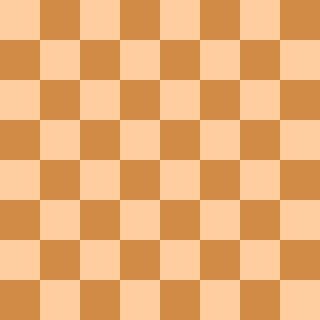
Aron Nimzowitsch was a Latvian-born Danish chess player and writer. He was the foremost figure amongst the hypermoderns and wrote a very influential book on chess theory: My System. In the late 1920s, he was one of the best chess players in the world.
This glossary of chess explains commonly used terms in chess, in alphabetical order. Some of these terms have their own pages, like fork and pin. For a list of unorthodox chess pieces, see Fairy chess piece; for a list of terms specific to chess problems, see Glossary of chess problems; for a list of named opening lines, see List of chess openings; for a list of chess-related games, see List of chess variants.

The French Defence is a chess opening characterised by the moves:
Zugzwang is a situation found in chess and other turn-based games wherein one player is put at a disadvantage because of their obligation to make a move; in other words, the fact that the player is compelled to move means that their position will become significantly weaker. A player is said to be "in zugzwang" when any possible move will worsen their position.

The King's Gambit is a chess opening that begins with the moves:
In chess, the fianchetto is a pattern of development wherein a bishop is developed to the second rank of the adjacent b- or g-file, the knight pawn having been moved one or two squares forward.

The Nimzowitsch Defence is a somewhat unusual chess opening characterised by the moves:

In chess, luft designates the space or square left by a pawn move into which a king may then retreat, especially such a space made intentionally to avoid back-rank checkmate. A move leaving such a space is often said to "give the king some luft". The term "luft", "lufting", or "lufted" may also be used to refer to the movement of the relevant pawn creating luft.

In chess, a passed pawn is a pawn with no opposing pawns to prevent it from advancing to the eighth rank; i.e. there are no opposing pawns in front of it on either the same file or adjacent files. A passed pawn is sometimes colloquially called a passer. Passed pawns can be an advantage because only the opponent's pieces can stop them from promoting.

In chess, an isolated pawn is a pawn that has no friendly pawn on an adjacent file. Isolated pawns are usually a weakness because they cannot be protected by other pawns. The square in front of the pawn may become a good outpost or otherwise a good square for the opponent to anchor pieces. Isolated pawns most often become weaker in the endgame, as there are fewer pieces available to protect the pawn.

Larsen's Opening is a chess opening starting with the move:

Handicaps in chess are variant ways to enable a weaker player to have a chance of winning against a stronger one. There are a variety of such handicaps, such as material odds, extra moves, extra time on the chess clock, and special conditions. Various permutations of these, such as "pawn and two moves", are also possible.

In the game of chess, Indian Defence or Indian Game is a broad term for a group of openings characterised by the moves:

The Queen's Knight Defense is a chess opening defined by the moves:
In chess, the fortress is an endgame drawing technique in which the side behind in material sets up a zone of protection that the opponent cannot penetrate. This might involve keeping the enemy king out of one's position, or a zone the enemy cannot force one out of. An elementary fortress is a theoretically drawn position with reduced material in which a passive defense will maintain the draw.
In chess, a blunder is a very bad move. It is usually caused by some tactical oversight, whether from time trouble, overconfidence or carelessness. While blunders are more common in amateur games, all players make them even at world championship level. While a blunder may seem like a stroke of luck, giving the opponent opportunities to blunder is an important skill in over the board chess.

In chess, a swindle is a ruse by which a player in a losing position tricks their opponent, and thereby achieves a win or draw instead of the expected loss. It may also refer more generally to obtaining a win or draw from a clearly losing position. I. A. Horowitz and Fred Reinfeld distinguish among "traps", "pitfalls", and "swindles". In their terminology, a "trap" refers to a situation where a player goes wrong through their own efforts. In a "pitfall", the beneficiary of the pitfall plays an active role, creating a situation where a plausible move by the opponent will turn out badly. A "swindle" is a pitfall adopted by a player who has a clearly lost game. Horowitz and Reinfeld observe that swindles, "though ignored in virtually all chess books", "play an enormously important role in over-the-board chess, and decide the fate of countless games".

The Immortal Zugzwang Game is a chess game between Friedrich Sämisch and Aron Nimzowitsch, played in Copenhagen in March 1923. It gained its name because the final position is sometimes considered a rare instance of zugzwang occurring in the middlegame. According to Nimzowitsch, writing in the Wiener Schachzeitung in 1925, this term originated in "Danish chess circles".

Jens Evald Enevoldsen-Elsing was a Danish chess master born in Copenhagen.

Éric Prié, born 14 March 1962 in Paris, is a French chess player, International Grandmaster since 1996, currently playing for Montpellier Échecs. He won the title of French Champion in 1995 and of Paris Champion in 1982, 1983, 1992 and 1996. He was part of the French team in the 29th, 31st, and 32nd Olympiads.






